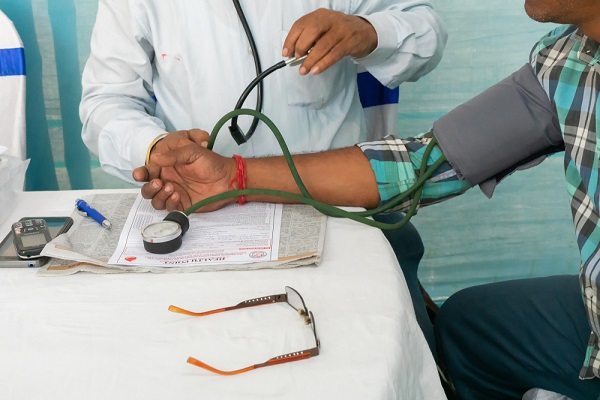TOPSPIN Study by the Centre for Chronic Disease Control (CCDC) Finds Two-drug Combination Therapies Effective in Improving Blood Pressure Control in Indians
A new study, entitled TOPSPIN, coordinated by the Centre for Chronic Disease Control (CCDC) New Delhi, in collaboration with the All India Institute of Medical Sciences (AIIMS) New Delhi, and Imperial College London, examined 1,981 patients with uncontrolled hypertension across 32 hospitals in India. The findings showed that three two-drug combination therapies – Amlodipine plus Perindopril, Amlodipine plus Indapamide, and Perindopril plus Indapamide – were equally effective and safe in lowering both ambulatory and office blood pressure. TOPSPIN is the first-ever randomised study to test the choice of first-line two-drug combination therapy in a single pill among South Asians. The study findings are published in Nature Medicine, one of the top medicine journals.
 |
A doctor checking the blood pressure of a patient
South-Asians represent one-fourth of the world population, and India alone constitutes one-sixth of the global population. Hypertension is a public health crisis affecting over one billion adults worldwide, including over 300 million living in India. Innovative solutions are needed to curb the growing tide of high blood pressure, which is the single highest risk factor for global deaths, and which requires effective management solutions. Current guidelines widely recommend initiating treatment with two-drug combinations, preferably in a single-pill formulation, to enhance blood pressure control. However, the suitability of these combinations for the South-Asian population remains unknown, as there are no studies in this regard.
The key takeaways are that all three combinations were equally effective in reducing blood pressure and were safe for patients.
What did the TOPSPIN study find
-
Blood pressure dropped significantly after 6 months, by around 14/8 mmHg when measured over 24 hours and about 30/14 mmHg in clinic settings.
-
Nearly 70% of patients reached the recommended blood pressure target below 140/90 mmHg, five times higher than India’s current average control rate.
-
The pills were well-tolerated, with less than 3% of patients reporting side effects serious enough to stop treatment.
â
What do the Study leaders say
“This study shows that a single daily pill with two drugs can be a simple and powerful way to manage blood pressure in Indian and South Asian patients,” said Prof. Dorairaj Prabhakaran, Executive Director of CCDC and one of the study’s lead authors. “These findings can help guide doctors and policymakers. If added to India’s list of essential medicines and made available at primary health centres, these pills could greatly improve blood pressure control in the country.”
Prof. Ambuj Roy, Professor of Cardiology at AIIMS Delhi, added, “Nearly 70% of patients got their blood pressure under control, a huge improvement over the current national average. And the pills were safe and easy to use. This study gives clear guidance for better hypertension care.”
Prof. Neil Poulter, Professor at Imperial College London, emphasized the importance of studying how medicines work in different populations. “Just as earlier research in Africa showed different results, this study gives strong evidence on what works best in South Asians.”
â
The TOPSPIN study results could help improve treatment not only in India, but also for South Asians living around the world.
![]()


